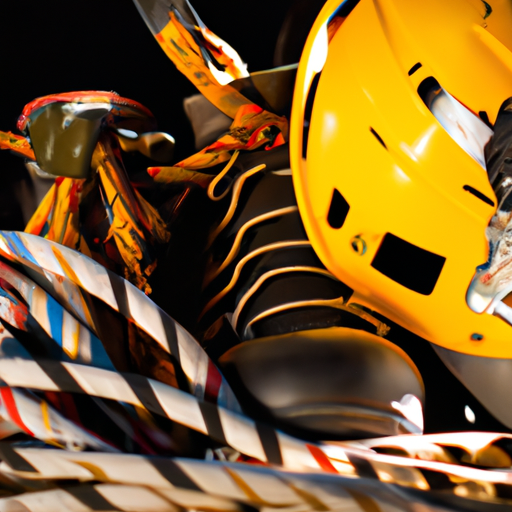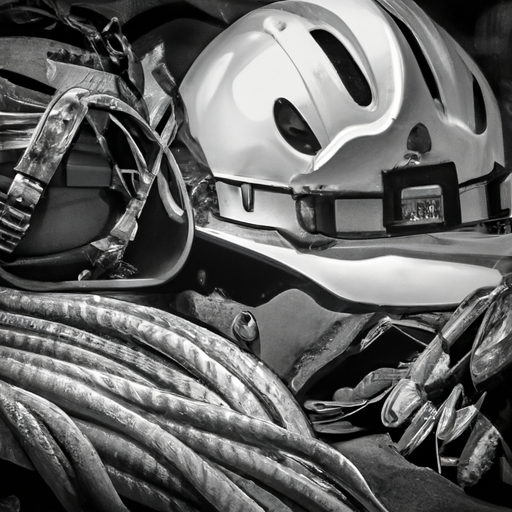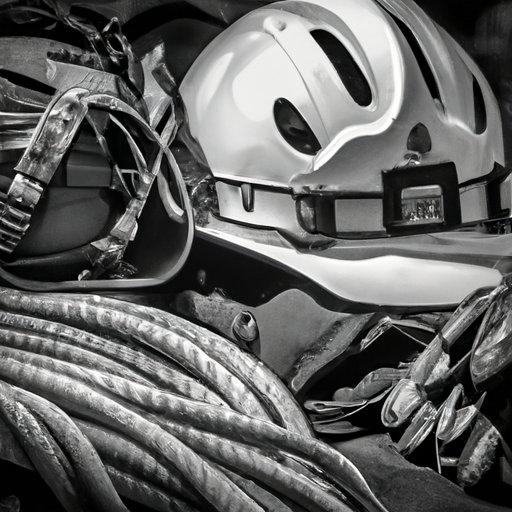Hey there! Are you curious about the essential gear that linemen use? Well, you’ve come to the right place. In this article, we’re going to dive into all the tools and equipment that linemen rely on to get their job done efficiently and safely. Whether you’re just curious about the profession or considering a career as a lineman yourself, this article will provide you with all the information you need about the gear linemen use on a daily basis.
In the next section, we’ll take a closer look at the different types of gear that linemen use. From safety equipment like hard hats and gloves, to climbing gear such as hooks and belts, we’ll explore the importance of each item and why it’s crucial for linemen to have them. We’ll also discuss the specialized tools that linemen use for their electrical work, including voltage testers, grounding equipment, and more. So, if you’re interested in learning more about the gear that makes a lineman’s job possible, keep reading and get ready to be amazed at the wide range of equipment linemen depend on to keep our lights on and our lives running smoothly.

Head Protection
Linemen often work in hazardous conditions, and head protection is vital to ensure their safety on the job. Two commonly used types of head protection in this profession are hard hats and safety helmets.
Hard Hats
Hard hats are a crucial piece of equipment for linemen. These hats are specifically designed to protect the head from falling objects and impact-related injuries. A hard hat consists of a rigid outer shell made of durable materials such as high-density polyethylene. Inside the shell, a suspension system helps absorb shock and provide additional comfort.
Hard hats usually feature an adjustable headband, allowing the wearer to customize the fit to ensure a secure and comfortable feel. They also often come with vents to promote airflow and keep the lineman cool during hot weather conditions. Some hard hats even have optional accessories like face shields or earmuffs for added protection.
Safety Helmets
Safety helmets offer a higher level of head protection compared to hard hats. They are specifically designed for linemen who work in high-risk environments with potential electrical hazards. These helmets have an additional layer of insulation to prevent electric shocks.
Safety helmets typically feature a non-conductive shell made of materials like fiberglass or composite plastics. This non-conductive nature of the helmet helps to protect linemen from accidental contact with electrical wires and other energized equipment. The suspension system inside the helmet ensures a comfortable fit, and some models also include an integrated visor for face protection.
Linemen need to choose between hard hats and safety helmets based on their work environment and the level of electrical hazard they may encounter. Both options provide essential head protection, but safety helmets offer an extra layer of safety against electrical shocks.
Fall Protection
When working at heights, fall protection is crucial for linemen to prevent accidents and injuries. Various fall protection equipment is available to keep them safe while working on poles, towers, or other elevated structures.
Harnesses
Safety harnesses are an essential part of fall protection gear for linemen. These harnesses are designed to distribute the forces generated during a fall and prevent severe injuries. They are typically made of high-strength nylon webbing and feature multiple attachment points for connecting lanyards or other fall arrest devices.
A well-fitted harness should be comfortable for the lineman to wear for long periods without causing discomfort or restrictions in movement. It is important to choose a harness that meets relevant safety standards and undergoes regular inspections to ensure its integrity.
Lanyards
Lanyards are another crucial component of fall protection gear for linemen. These flexible lines connect the safety harness to an anchor point, preventing the lineman from falling in the event of a slip or trip. Lanyards are available in various lengths and materials, depending on the specific requirements of the job.
The most common types of lanyards used by linemen include shock-absorbing lanyards, which are designed to reduce the impact of a fall, and positioning lanyards, which allow the lineman to work hands-free while being securely attached to the structure.
Self-Retracting Lifelines
Self-retracting lifelines (SRLs) are devices that automatically retract and store the lifeline cable after it has been extended. This feature helps eliminate slack in the line, reducing the risk of a lineman tripping over excess cable. SRLs are often used in conjunction with harnesses and lanyards to provide an additional layer of fall protection.
SRLs come in various lengths and can be attached to an anchor point or a lifeline system. They are typically made of durable materials such as stainless steel or high-strength nylon and are designed to withstand the forces generated during a fall.
Hand and Arm Protection
Linemen frequently work with their hands and arms, and it is essential to protect these body parts from potential injuries. Several types of gear are available to provide hand and arm protection for linemen.
Insulated Rubber Gloves
Insulated rubber gloves play a vital role in protecting linemen from electrical shocks while working on or near energized equipment. These gloves are designed to provide a barrier between the wearer’s hands and the electrical current. They are made of a combination of rubber and insulating materials, ensuring electrical conductivity is minimal.
Insulated rubber gloves undergo rigorous testing to meet industry safety standards. Linemen should regularly inspect their gloves for any signs of wear or damage and replace them promptly if necessary.
Leather Protector Gloves
Leather protector gloves are worn over the insulated rubber gloves to provide an additional layer of protection. These gloves are made of high-quality leather and are designed to protect the insulation of the rubber gloves from cuts, punctures, and abrasions.
By wearing leather protector gloves, linemen can extend the lifespan of their insulated rubber gloves and reduce the risk of damage. Linemen should ensure that the leather gloves fit comfortably and provide adequate dexterity for their specific tasks.
Sleeves
In addition to gloves, linemen often wear protective sleeves to safeguard their arms from cuts, burns, or other potential hazards. These sleeves are typically made of flame-resistant materials like Kevlar or Nomex, ensuring that they can withstand high temperatures and resist cuts or tears.
Sleeves are available in various lengths and styles, allowing linemen to choose the most suitable option based on their specific needs. Properly fitted sleeves that cover the entire arm provide an extra layer of protection and peace of mind.
Hand Tools
Linemen rely on a variety of hand tools to perform their daily tasks. These tools, such as lineman’s pliers, cable cutters, and screwdrivers, are specially designed to facilitate the lineman’s work and ensure their safety.
Lineman’s pliers, also known as combination pliers, are a versatile tool that can grip, twist, and cut wires. They have a strong cutting edge that can handle different types of cables, making them essential for linemen. Cable cutters are designed specifically for cutting wires and cables cleanly and efficiently.
Screwdrivers with insulation on their handles are used to work on parts that may be live or carry an electric charge. These insulated screwdrivers help prevent electric shocks by providing a protective barrier between the lineman’s hand and the conductive components.
Using the right hand tools and ensuring they are in good condition can significantly reduce the risk of injuries and improve efficiency for linemen.
Footwear
Linemen often work in challenging terrain and adverse weather conditions, making appropriate footwear essential for their safety, comfort, and productivity.
Steel-Toe Boots
Steel-toe boots are a common choice for linemen due to their durability and protective features. These boots have a reinforced toe cap made of steel, which protects the lineman’s feet from impact and compression hazards.
Steel-toe boots are also designed to provide traction and stability on various surfaces, preventing slips and falls. They often have features like waterproofing and insulation, making them suitable for different weather conditions.
Lineman Boots
Lineman boots, also known as pole-climbing boots, are specifically designed to meet the unique needs of linemen. These boots have a high-top design that provides ankle support and stability during climbing and working on poles or towers.
Lineman boots typically feature a non-conductive sole to minimize the risk of electrical shocks. The sole is often made of a slip-resistant material that offers excellent grip and traction, even on slippery or uneven surfaces.
Climbing Spurs
Climbing spurs, also known as climbing gaffs or spurs, are an essential tool for linemen working on wooden poles. These sharp spikes are strapped onto the lineman’s boots and provide the necessary grip to climb vertically.
Climbing spurs should only be used by experienced and trained linemen. When not in use, they can be detached from the boots to prevent accidental injuries or damage to other surfaces.
Proper footwear is crucial for linemen to ensure their safety and enhance their performance while working at heights or in challenging environments.

Protective Clothing
Protective clothing is essential for linemen to safeguard themselves from various workplace hazards. It provides protection against fire, extreme weather conditions, and enhances visibility on the job.
Flame-Resistant Clothing
Flame-resistant clothing, often made of materials like Nomex or Kevlar, is designed to protect linemen from flash fires or electrical arc flashes. These garments are self-extinguishing and do not contribute to the spread of fire.
Flame-resistant clothing includes coveralls, shirts, pants, and jackets that meet industry safety standards. Properly fitted flame-resistant clothing, when combined with other personal protective equipment, significantly reduces the risk of severe burns or injuries for linemen working in hazardous conditions.
Rain Gear
Working in inclement weather is common for linemen, and having appropriate rain gear is necessary to stay dry and comfortable. Rain gear typically includes waterproof jackets and pants that provide protection against rain, wind, and cold temperatures.
High-quality rain gear is made of durable materials that are both water-resistant and breathable. It should include features like sealed seams, adjustable cuffs, and a hood to keep linemen dry and protected from the elements.
High Visibility Vests
High visibility vests are essential for linemen working near roadways or in low-light conditions. These vests are made of brightly colored materials, often fluorescent orange or yellow, with reflective strips that make the wearer highly visible to others.
Wearing a high visibility vest helps alert motorists and other workers to the presence of linemen on the job site, reducing the risk of accidents or injuries. Linemen should ensure that their vests meet relevant safety standards and are in good condition to maximize their visibility and safety.
Proper protective clothing is crucial for linemen to shield themselves from various workplace hazards and ensure their well-being.
Climbing and Rigging Tools
Climbing and rigging tools are essential gear for linemen as they enable them to safely ascend poles or towers and perform their tasks efficiently.
Climbing Gear
Climbing gear includes equipment like climbing belts, hooks, straps, and other devices that assist linemen in ascending and descending poles or towers. These tools provide stability and support while working at heights and ensure the lineman’s safety throughout the climbing process.
Climbing belts, or lineman’s belts, are worn around the waist and have D-rings or buckles to attach safety lanyards and other climbing accessories. Hooks and straps help secure the lineman to the structure, allowing them to work hands-free when necessary.
Pole Steps
Pole steps, also known as climbing pegs or gaffs, are metal or wooden devices that are driven into utility poles to provide footholds for linemen. These steps allow the lineman to climb vertically, maintain stability, and perform their tasks more effectively.
Pole steps should be inspected regularly to ensure they are securely fastened and in good condition. Proper training and experience are necessary for the safe and efficient use of pole steps.
Rigging Equipment
Rigging equipment is essential for linemen engaged in tasks like lifting heavy objects, pulling cables, or setting up temporary lines. This equipment includes items like hoists, winches, rigging slings, and pulleys, which facilitate safe and controlled movement of loads.
Rigging equipment should be properly inspected and maintained to ensure its integrity and functionality. Linemen should receive adequate training on the correct usage of rigging equipment to prevent accidents and injuries.
Climbing and rigging tools are indispensable for linemen as they enable them to access elevated structures and carry out their work efficiently and safely.
Safety Equipment
Safety equipment is critical for linemen to minimize the risk of injuries and protect their senses from potential hazards.
Safety Glasses
Safety glasses are an essential piece of safety equipment that protects the linemen’s eyes from flying debris, dust, or other particles. These glasses often have impact-resistant lenses made of polycarbonate or other durable materials.
Safety glasses should fit properly and provide a comfortable seal around the eyes. They are available in various styles, including prescription glasses for linemen with corrective vision needs. Wearing safety glasses is crucial for maintaining clear vision and preventing eye injuries on the job.
Ear Plugs
Linemen are often exposed to loud noise levels, such as those generated by machinery or equipment. To protect their hearing, linemen should use ear plugs, which act as a barrier against excessive noise.
Disposable foam ear plugs are a common choice as they are inexpensive, easy to use, and provide effective noise reduction. Linemen can also opt for reusable ear plugs made of silicone or other materials that offer a longer lifespan and can be cleaned regularly.
Regular use of ear plugs can help prevent noise-induced hearing loss and promote overall auditory wellness for linemen.
Respiratory Protection
In certain situations, linemen may be exposed to hazardous airborne substances, such as dust, fumes, or chemicals. Respiratory protection gear, such as masks or respirators, is necessary to prevent inhalation of these harmful particles.
Different types of respiratory protection are available, ranging from disposable masks to filtered respirators. The selection of the appropriate respiratory gear depends on the specific environment and potential airborne hazards.
Linemen should receive proper training on the usage, maintenance, and storage of respiratory protection equipment to ensure its effectiveness.
Electrical Testing Equipment
Electrical testing equipment is essential for linemen to ensure the safety and integrity of electrical systems they work on.
Voltage Testers
Voltage testers are used to measure and indicate the presence or absence of electrical voltage. These handheld devices help linemen identify live circuits, faulty wiring, or potential electrical hazards.
Voltage testers come in various types, including non-contact testers, test pens, and multimeters. Linemen should choose the appropriate voltage tester based on their specific requirements and receive proper training on its usage.
Insulation Testers
Insulation testers, also known as megohmmeters or “meggers,” are used to measure the insulation resistance of electrical systems or equipment. These devices help linemen identify insulation faults or degradation that can lead to malfunctions or electrical shocks.
Insulation testers send a high voltage through the system and measure how well it resists the flow of current. They provide linemen with valuable information about the health of the insulation and aid in preventive maintenance efforts.
Grounding Equipment
Grounding is an essential safety measure to prevent electrical shock or equipment damage. Linemen use various grounding equipment, including grounding rods, clamps, and cables, to establish a safe electrical path to the ground.
Grounding equipment helps divert excess electrical current away from the lineman, machinery, or sensitive electronic devices. It ensures the effective operation of protective devices like circuit breakers or fuses by providing a low-resistance pathway for fault currents.
Communication Tools
Clear and reliable communication is essential for linemen to coordinate their tasks efficiently and maintain overall safety on the job.
Two-Way Radios
Two-way radios, also known as walkie-talkies, are commonly used by linemen to communicate with their team members and supervisors. These handheld devices enable instant communication and help coordinate work activities, especially in large work areas or remote locations.
Two-way radios should have adequate range and battery life to ensure uninterrupted communication throughout the workday. Linemen should follow proper radio etiquette and receive training on the devices’ features and settings.
Cell Phones
Cell phones are increasingly being used as a communication tool by linemen. Cellular networks provide broader coverage compared to two-way radios, allowing linemen to stay connected even in remote areas.
Cell phones offer a range of communication options beyond voice calls, including text messaging, emails, and access to various apps. They can also serve as a valuable tool for accessing work-related documents or conducting online research when needed.
Hands-Free Headsets
Hands-free headsets, or Bluetooth headsets, are a convenient accessory for linemen who need to maintain communication while keeping their hands and attention focused on their tasks. These headsets allow linemen to make and receive calls without having to hold a phone or device.
Hands-free headsets are designed to fit comfortably and securely, even in active work environments. They often have noise-canceling features to improve the clarity of communication in noisy surroundings.
Clear and efficient communication tools are vital for linemen to coordinate their activities, receive instructions, and maintain overall job site safety.
Conclusion
The essential gear discussed in this article highlights the importance of proper equipment for linemen to perform their duties safely and efficiently. From head protection to communication tools, each piece of gear plays a crucial role in ensuring their well-being and adherence to industry standards.
By investing in high-quality gear and following proper maintenance and usage guidelines, linemen can enhance their safety, productivity, and job satisfaction. This essential gear helps protect linemen from potential hazards, including falls, electrical shocks, and exposure to hazardous substances.
As a lineman, remember that your safety is paramount. Always assess the specific risks of your working environment and select the appropriate gear accordingly. Regularly inspect your equipment, ensure proper training, and stay updated with industry safety standards to ensure your safety while on the job.
Linemen play a vital role in maintaining and expanding our electrical infrastructure, and it is crucial to prioritize their safety by providing them with the essential gear they need for their daily tasks.




